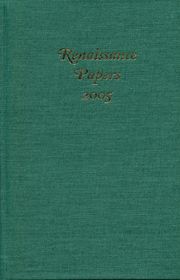Book contents
- Frontmatter
- Contents
- Renaissance Papers
- Bronzino, Castiglione, and A Self-Portrait: Re-evaluating Bronzino's Trip to Pesaro
- Tracing Astrophil's “Coltish Gyres”: Sidney and the Horses of Desire
- Shakespeare's Twins: Choric Juxtaposition
- Rhetoric and Intimacy in The Tempest
- “That Holy roome”: John Donne and the Conduct of Worship at St. Paul's Cathedral
- Conversation in Hutchinson's Order and Disorder and Milton's Paradise Lost
- Dryden on Epicoene's “Malicious Pleasure”: The Case of the Otters
Rhetoric and Intimacy in The Tempest
Published online by Cambridge University Press: 12 September 2012
- Frontmatter
- Contents
- Renaissance Papers
- Bronzino, Castiglione, and A Self-Portrait: Re-evaluating Bronzino's Trip to Pesaro
- Tracing Astrophil's “Coltish Gyres”: Sidney and the Horses of Desire
- Shakespeare's Twins: Choric Juxtaposition
- Rhetoric and Intimacy in The Tempest
- “That Holy roome”: John Donne and the Conduct of Worship at St. Paul's Cathedral
- Conversation in Hutchinson's Order and Disorder and Milton's Paradise Lost
- Dryden on Epicoene's “Malicious Pleasure”: The Case of the Otters
Summary
WE split! We split!” comes the despairing cry in the opening scene of The Tempest, as those on board fear not only their broken ship but their broken families: “‘Farewell, my wife and children!’— / ‘Farewell, brother!’” We soon learn that the ship is whole, “Safely in harbor” (I.ii.226), but it will take the rest of the play to acknowledge if not heal all the splits between and within the characters. The healing power of intimacy—of pity, empathy, and care—paradoxically is attained only through the act of separation and distancing, voiced in the rhetoric of the play and visualized in Prospero's three vivid creations: the shipwreck (I.i), the banquet (III.iii), and the masque (IV.i). Prospero, in particular, must distance himself from himself, observing himself as well as others, before he can extend his hand in forgiveness and love. Language in this play will be a vehicle of empathy for Prospero, but not for everyone. All the empathic capacities of language, which Miranda believes enable one to “Know thine own meaning,” are negated by Caliban's hatred and rage: “You taught me language, and my profit on't / Is, I know how to curse. The red-plague rid you / For learning me your language!” (I.ii.363-65).
Miranda's rhetoric of empathy offers the first model for overcoming distance. Her cry to her “dearest father” echoes the cry of those on board the ship: “O! I have suffered / With those that I saw suffer. A brave vessel / … / Dashed all to pieces! O, the cry did knock / Against my very heart” (I.ii.5-9).
- Type
- Chapter
- Information
- Renaissance Papers 2005 , pp. 51 - 60Publisher: Boydell & BrewerPrint publication year: 2006



